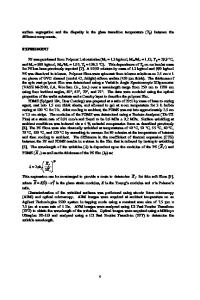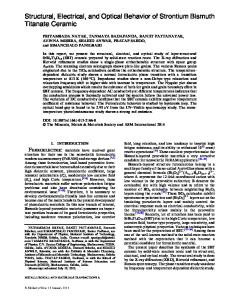Anomalous Magnetoresistance Behavior of Bismuth Antidot Arrays
- PDF / 947,590 Bytes
- 6 Pages / 612 x 792 pts (letter) Page_size
- 20 Downloads / 367 Views
L12.1.1
Anomalous Magnetoresistance Behavior of Bismuth Antidot Arrays. Oded Rabin (a), Mildred S. Dresselhaus (b,c) Massachusetts Institute of Technology, Cambridge, MA 02139, U.S.A. (a) Dept. of Chemistry. (b) Dept. of Physics. (c) Dept. of Electrical Engineering and Computer Science. ABSTRACT Antidot arrays were formed in thin films of bismuth by the e-beam evaporation of the metal on the porous surface of porous anodic alumina templates. The magnetoresistance of the antidot array films was measured and compared to that of films deposited on glass slides. A significant difference in magnetoresistance behavior was observed, and this difference was attributed to the enhancement of the two dimensional weak antilocalization effect in the antidot arrays. Scattering rates were obtained by fitting the experimental results to the theoretical expression. The results indicate that the antidot morphology enhances the elastic scattering rate over the inelastic scattering rate. INTRODUCTION Weak localization and weak antilocalization effects are manifestations of quantum coherence between electrons traveling in a crystal subject to a random scattering potential [1]. These effects can be observed in macroscopic samples via the temperature and the magnetic field dependences of the electrical resistance. The theory of weak (anti)localization has been well established, and a good correlation has been observed between theory and experiments [1]. Using the theoretical expressions for the magnetoresistance, the measurements provide valuable information regarding the time constants (or the characteristic lengths) of the relaxation mechanisms for weak (anti)localization in the samples: the elastic and the inelastic scattering, and the spin-orbit and the spin-spin interactions. Since the weak localization effect is sensitive to the ratio of the elastic scattering rate to the inelastic scattering rate, the morphology of the sample plays a crucial role in determining the strength of the localization. Thus, tools for the engineering of the crystalline structure at the nanoscale could be used to regulate the scattering mechanisms, and advance fundamental studies of weak antilocalization by making this phenomenon more pronounced. Two-dimensional weak localization effects have been studied in disordered thin metallic films [2-5], and in high-mobility inversion layers in semiconductor heterostructures [6]. We are not aware, however, of observations of weak (anti)localization effects in metallic films patterned with an antidot array (possibly because of the lack of patterning techniques on the nanometer scale at the time when weak localization was a popular research subject). Recently, weak antilocalization effects were observed in a single crystal bismuth nanocavity [7]. Here, we revisit the weak antilocalization effect in two dimensional bismuth films, and study the effect of a submicron antidot morphology on the magnetoresistance properties of the film.
L12.1.2
EXPERIMENTAL DETAILS
(a)
(b)
pores
Al2O3 Al
100nm
bismuth grain pore
Data Loading...










